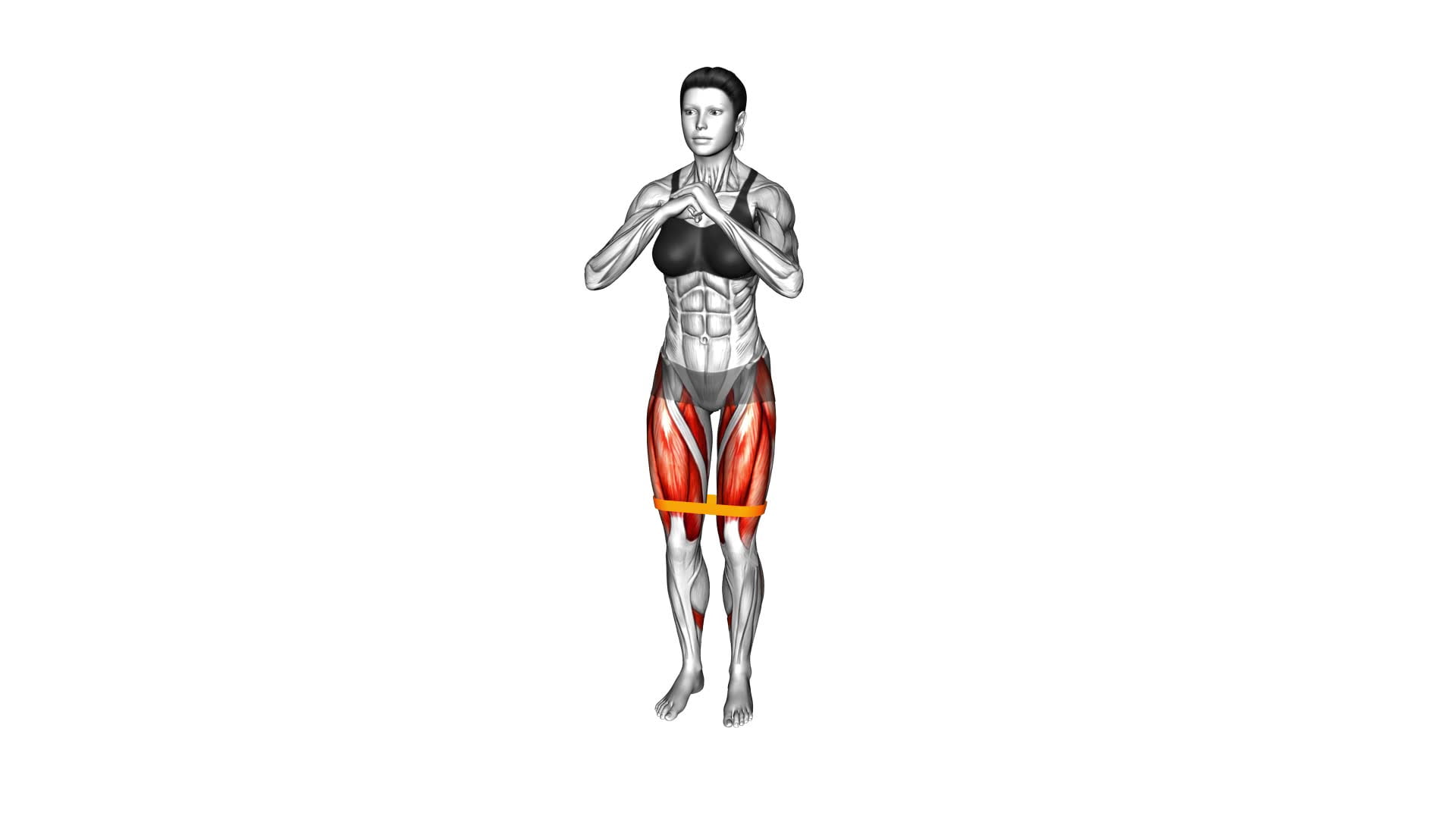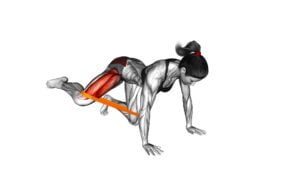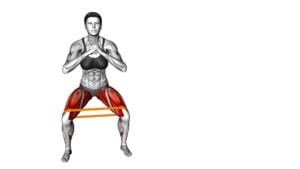Resistance Band Side Lunge (female) – Video Exercise Guide & Tips

Get ready to tone and strengthen your legs with the resistance band side lunge.
Watch This Exercise Video
In this video exercise guide, you'll learn how to properly perform this effective exercise using a resistance band.
With clear instructions and helpful tips, you'll be able to maximize your workout and avoid common mistakes.
So grab your resistance band and get ready to take your lunges to the next level!
Key Takeaways
- Resistance Band Side Lunge targets glutes, quads, hamstrings, and inner thighs.
- Incorporating this exercise improves lower body strength and stability.
- Resistance band exercises increase muscle strength, definition, and stability.
- Proper form and technique, including band placement, are crucial for effective and safe execution of the exercise.
Benefits of Resistance Band Side Lunge
Get stronger and tone your lower body muscles with the Resistance Band Side Lunge. Resistance band exercises offer numerous benefits for your fitness routine. One of the main advantages is that they provide constant tension throughout the entire range of motion, which helps to activate and engage your muscles more effectively. This can lead to improved muscle strength and endurance.
The Resistance Band Side Lunge specifically targets your glutes, quads, hamstrings, and inner thighs. By incorporating this exercise into your workout routine, you can strengthen and tone these muscles, helping to improve your overall lower body strength and stability.
Resistance bands come in different types, including loop bands and tube bands. Loop bands are great for lower body exercises like the Side Lunge as they provide resistance from all directions. Tube bands, on the other hand, are versatile and can be used for a wide range of exercises, including upper body workouts.
Incorporating resistance band exercises like the Side Lunge into your fitness routine can help increase muscle strength, improve muscle definition, and enhance overall stability. They're also a convenient and portable option for home workouts or when traveling.
Equipment Needed for Resistance Band Side Lunge
To perform the Resistance Band Side Lunge, you'll need the following equipment:
- Resistance Band: A resistance band is an essential tool for this exercise. It provides the necessary resistance to challenge your muscles and help you build strength and stability. Make sure to choose a band with the right level of resistance for your fitness level.
- Comfortable Athletic Shoes: Having a pair of good athletic shoes is crucial for any exercise, including resistance band exercises. They provide support and stability to your feet and ankles, reducing the risk of injuries.
- Mat or Non-Slip Surface: Having a mat or a non-slip surface is important to ensure your safety and stability during the exercise. It helps prevent slipping and provides a comfortable surface for your feet.
These are the basic equipment you need to perform the Resistance Band Side Lunge effectively.
However, if you don't have access to a resistance band, there are alternative exercises you can try. Some alternatives include using dumbbells or kettlebells to add resistance, or performing bodyweight lunges without any equipment.
Remember to always consult with a fitness professional or trainer to ensure proper form and technique when performing resistance band exercises or alternative exercises.
Proper Form and Technique for Resistance Band Side Lunge
Maintain proper form and technique while performing the Resistance Band Side Lunge to maximize the effectiveness of the exercise. To ensure you're performing the side lunge correctly, it's important to avoid common mistakes and follow proper form tips.
One common mistake to avoid is allowing your knee to extend beyond your toes as you lunge to the side. This puts excessive strain on your knee joint and can lead to injury. Instead, focus on keeping your knee in line with your toes, ensuring proper alignment and stability.
Another mistake isn't engaging your core muscles. Your core plays a crucial role in maintaining balance and stability during the side lunge. To properly engage your core, imagine pulling your belly button towards your spine throughout the entire movement.
Proper form tips include keeping your chest lifted and your back straight throughout the exercise. Avoid leaning forward or rounding your shoulders, as this can lead to poor posture and potential strain on your back.
Additionally, make sure to step out wide enough during the lunge so that your knee is directly above your ankle. This will help maintain proper alignment and prevent any unnecessary stress on your joints.
Variations and Modifications for Resistance Band Side Lunge
To add variety and challenge to your resistance band side lunge workout, you can explore different variations and modifications. Here are three options to consider:
- Resistance Band Overhead Side Lunge: Instead of holding the resistance band at your sides, extend your arms overhead, holding the band with both hands. As you perform the side lunge, keep your arms straight and engage your core to maintain stability.
- Banded Side Lunge with Rotation: Begin in the side lunge position, with the resistance band in front of your chest. As you lower into the lunge, rotate your torso towards the side of your leading leg. This variation adds an element of rotational movement, engaging your obliques and enhancing core strength.
- Banded Side Lunge with Pulse: Start in the side lunge position and hold the resistance band at your sides. Instead of returning to the starting position after each lunge, stay in the lowered position and perform small pulses up and down. This modification helps to increase the time under tension and further challenge your leg muscles.
By incorporating these variations and modifications into your resistance band side lunge routine, you can target different muscle groups, increase the difficulty level, and keep your workouts fresh and exciting.
Remember to listen to your body and adjust the resistance band tension or range of motion as needed to ensure proper form and prevent injury.
Common Mistakes to Avoid During Resistance Band Side Lunge
To perform the resistance band side lunge correctly, make sure you maintain proper form throughout the exercise.
Keep your chest up, back straight, and engage your core for stability.
Additionally, ensure that the resistance band is placed securely around your thighs, just above the knees.
Lastly, be mindful of not overextending your knees past your toes to avoid unnecessary strain on the joints.
Proper Form Tips
Avoid collapsing your upper body forward during the Resistance Band Side Lunge exercise. Maintaining proper form is crucial to maximize the benefits and prevent injury. Here are some common mistakes to avoid during this exercise:
- Rounding your shoulders: Keep your shoulders back and down to maintain a neutral spine and engage your core effectively.
- Allowing your knees to collapse inward: Make sure to keep your knees in line with your toes to avoid strain on the knees and promote proper alignment.
- Not engaging your glutes: Remember to squeeze your glutes as you push back up from the lunge position to activate the muscles properly.
By avoiding these common mistakes, you'll be able to perform the Resistance Band Side Lunge exercise more effectively.
Now, let's move on to the next section and discuss the correct band placement.
Correct Band Placement
To ensure proper form and maximize the benefits of the Resistance Band Side Lunge exercise, it's important to place the band correctly around your legs. The correct band placement for this exercise is just above your knees. This ensures that the band provides the necessary resistance without interfering with your movement.
One common mistake is placing the band too high up on your thighs, which can restrict your range of motion and hinder the effectiveness of the exercise. Another common mistake is placing the band too low, near your ankles, which can cause it to slip or become uncomfortable during the movement.
By placing the band correctly above your knees, you can maintain control and stability throughout the exercise, allowing you to fully engage your leg muscles. This proper band placement sets the foundation for a successful Resistance Band Side Lunge workout.
Now, let's move on to the next important aspect of this exercise: avoiding knee overextension.
Avoiding Knee Overextension
By keeping your knees slightly bent throughout the Resistance Band Side Lunge exercise, you can avoid knee overextension and prevent potential injuries. Overextending the knee puts excessive strain on the joint and can lead to knee pain or even more serious injuries like ligament tears.
Here are some tips to help you avoid knee overextension during the exercise:
- Focus on maintaining a slight bend in your knees throughout the movement.
- Keep your core engaged and your weight centered over your heels.
- Make sure your knees track in line with your toes to avoid any sideways movement that could stress the joint.
In addition to knee injury prevention, the Resistance Band Side Lunge exercise can also help strengthen your hip muscles. Strong hip muscles provide stability and support to the knees, reducing the risk of injury during various activities.
Tips for Getting the Most Out of Resistance Band Side Lunge
Maximize your results with the Resistance Band Side Lunge by engaging your glutes and quads through controlled, dynamic movements. To get the most out of this exercise, here are some tips to keep in mind.
Firstly, it's important to choose the right resistance band. Select a band that provides enough tension to challenge your muscles, but not too much that it compromises your form. This will ensure that you're working at an appropriate intensity level and maximizing your results.
When performing the resistance band side lunge, focus on maintaining proper form throughout the movement. Keep your chest up, shoulders back, and core engaged. This will help you target the correct muscles and avoid unnecessary strain on your joints.
Another tip is to control the speed of your movements. Slowly lower into the side lunge, making sure to push your hips back and keep your knees in line with your toes. This will help activate your glutes and quads more effectively.
Lastly, don't forget to breathe. Inhale as you lower into the side lunge and exhale as you push off and return to the starting position. Proper breathing technique will help you maintain control and power throughout the exercise.
Frequently Asked Questions
How Many Calories Can I Burn by Doing Resistance Band Side Lunges?
Resistance band side lunges are a great way to burn calories and improve overall fitness. By incorporating resistance bands into your workout routine, you can increase the intensity and effectiveness of the exercise.
Side lunges target multiple muscle groups, including the glutes, quadriceps, and hamstrings, which helps to boost calorie burn. To maximize the benefits, make sure to maintain proper form and engage your core throughout the movement.
Can Resistance Band Side Lunges Help Me Lose Weight?
Resistance band side lunges can be a great addition to your weight loss routine. They offer numerous benefits, such as targeting your lower body muscles and improving balance.
By incorporating resistance bands, you can increase the intensity of the exercise and burn more calories.
To maximize weight loss, focus on proper form by keeping your back straight, stepping out with a wide stance, and engaging your glutes and thighs.
Remember to consult a fitness professional for personalized advice.
Is It Safe to Do Resistance Band Side Lunges if I Have Knee Pain?
If you're experiencing knee pain, it's important to prioritize your safety when choosing exercises. Resistance band side lunges may not be the best option for you.
However, there are alternative exercises that can help you manage knee pain while still working on strengthening your legs.
It's best to consult with a healthcare professional or a certified trainer who can provide you with personalized guidance and recommend exercises that are safe and effective for your specific condition.
How Often Should I Incorporate Resistance Band Side Lunges Into My Workout Routine?
To get maximum results, incorporate resistance band side lunges into your workout routine regularly. Start by doing them 2-3 times a week and gradually increase the frequency as you get stronger.
Remember to focus on proper form and technique to avoid any knee pain.
To progress with resistance band side lunges, you can increase the tension of the band or add weights for added resistance.
Consistency is key for seeing improvements in your fitness journey.
Can Resistance Band Side Lunges Help Improve My Balance and Stability?
Resistance band side lunges can definitely improve your balance and stability. By adding resistance to the exercise, your muscles are forced to work harder to maintain control and stability. This helps strengthen the muscles in your legs, hips, and core, which are essential for balance.
Additionally, resistance band side lunges can also help improve flexibility as you stretch your muscles and increase your range of motion. There are also variations of resistance band side lunges that you can try to challenge yourself even more.
Conclusion
Incorporating resistance band side lunges into your workout routine can offer numerous benefits. This exercise is known for strengthening your lower body muscles and improving your balance and stability. By using the right equipment and maintaining proper form, you can effectively target your glutes, quads, and hamstrings. It's important to avoid common mistakes and make necessary modifications to maximize the effectiveness of this exercise. Always listen to your body and consult a professional if you have any concerns or questions. Get the most out of your resistance band side lunges and elevate your fitness journey.

Author
Years ago, the spark of my life’s passion ignited in my mind the moment I stepped into the local gym for the first time. The inaugural bead of perspiration, the initial endeavor, the very first surge of endorphins, and a sense of pride that washed over me post-workout marked the beginning of my deep-seated interest in strength sports, fitness, and sports nutrition. This very curiosity blossomed rapidly into a profound fascination, propelling me to earn a Master’s degree in Physical Education from the Academy of Physical Education in Krakow, followed by a Sports Manager diploma from the Jagiellonian University. My journey of growth led me to gain more specialized qualifications, such as being a certified personal trainer with a focus on sports dietetics, a lifeguard, and an instructor for wellness and corrective gymnastics. Theoretical knowledge paired seamlessly with practical experience, reinforcing my belief that the transformation of individuals under my guidance was also a reflection of my personal growth. This belief holds true even today. Each day, I strive to push the boundaries and explore new realms. These realms gently elevate me to greater heights. The unique combination of passion for my field and the continuous quest for growth fuels my drive to break new ground.



